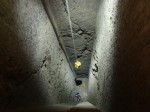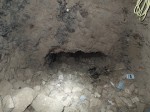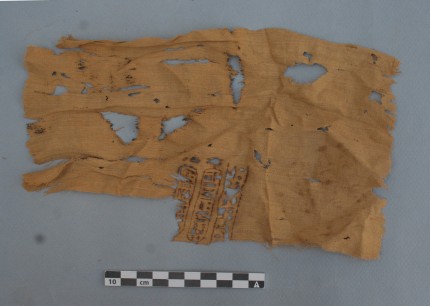 The Polish Archaeological Mission team has been excavating the ancient site of Sheikh Abd el-Qurna, a Pharaonic necropolis in what is today Luxor that was converted into a hermitage by Coptic monks in the 6th century, for more than a decade. The Mission’s aim is to explore how the ancient structures were reused, how objects and materials migrated from original burials to secondary burials to other locations in the Theban necropolis. This season’s work from February 5th to March 1st explored objects from the Coptic hermitage, for instance the large number of wine amphorae found that archaeologists believe were used to transport water to the hermitage and once emptied were used by the monks to store goods like ochre that they could sell to support themselves, and the shaft of a tomb from the Pharaonic period.
The Polish Archaeological Mission team has been excavating the ancient site of Sheikh Abd el-Qurna, a Pharaonic necropolis in what is today Luxor that was converted into a hermitage by Coptic monks in the 6th century, for more than a decade. The Mission’s aim is to explore how the ancient structures were reused, how objects and materials migrated from original burials to secondary burials to other locations in the Theban necropolis. This season’s work from February 5th to March 1st explored objects from the Coptic hermitage, for instance the large number of wine amphorae found that archaeologists believe were used to transport water to the hermitage and once emptied were used by the monks to store goods like ochre that they could sell to support themselves, and the shaft of a tomb from the Pharaonic period.
The Mission has for several seasons explored two Middle Kingdom (2055 B.C. – 1650 B.C.) tombs destined for high-ranking courtiers of an unknown pharaoh (possibly Mentuhotep IV) whose tomb complex was constructed in the neighboring valley in the late 11th or early 12th Dynasty. The tombs in the hillside around the pharaonic funerary complex were in a privileged position and reserved for important dignitaries. This year the team focused on the shaft of tomb MMA 1152 which was first excavated by the French Mission at Deir el-Medina in the early 1920s. There are no notes or documentation of any kind surviving from that excavation.
 The shaft, which is 18 meters (59 feet) long, has been exposed ever since. To explore the shaft safely, the Polish Archaeological Mission installed a wooden structure over the outlet to allow quick vertical transportation of people and materials and used the latest and greatest mountaineering equipment. At the bottom of the shaft is a corridor five and a half feet wide that descends diagonally eastward for 4.6 meters (15 feet) ending in another vertical shaft. Next season archaeologists plan to explore the second shaft in the hopes that it might lead to a burial chamber.
The shaft, which is 18 meters (59 feet) long, has been exposed ever since. To explore the shaft safely, the Polish Archaeological Mission installed a wooden structure over the outlet to allow quick vertical transportation of people and materials and used the latest and greatest mountaineering equipment. At the bottom of the shaft is a corridor five and a half feet wide that descends diagonally eastward for 4.6 meters (15 feet) ending in another vertical shaft. Next season archaeologists plan to explore the second shaft in the hopes that it might lead to a burial chamber.
 Meanwhile, the excavation of the bottom of the shaft, the corridor and a niche on the north wall of the shaft unearthed fragments of limestone, flint, mud bricks, ceramics from the Pharaonic and Coptic eras, pieces of wood, including coffin fragments, pieces of cartonnage, rope, faience beads and amulets, clay ushabti figurines, textile fragments from shrouds and mummification bandages. Human and animal bones were also found. The finds indicate the tomb was reused for burials in the Third Intermediate Period and Late Period and extensively robbed after that.
Meanwhile, the excavation of the bottom of the shaft, the corridor and a niche on the north wall of the shaft unearthed fragments of limestone, flint, mud bricks, ceramics from the Pharaonic and Coptic eras, pieces of wood, including coffin fragments, pieces of cartonnage, rope, faience beads and amulets, clay ushabti figurines, textile fragments from shrouds and mummification bandages. Human and animal bones were also found. The finds indicate the tomb was reused for burials in the Third Intermediate Period and Late Period and extensively robbed after that.
The star find is a piece of linen with hieroglyphics written on it in ink. There are two columns of text that include the cartouche of Ptolemy XII Auletes (80-51 B.C.), father of Queen Cleopatra, last queen of Egypt, seventh of her name but the only one to make it immortal. A third column text, thought to be a 3rd century addition, includes the name and epithets of the goddess Isis.

According to the researchers, the piece of cloth was a velum, a curtain covering a holy image (perhaps a statue representing a deity) in the nearby temple of Hathor, located near Deir el-Medina — a village of artisans who worked on the royal tombs in the Valley of the Kings, including the tomb of Tutankhamun.
“Velum was probably Ptolemy XII’s gift to the deity. Pharaoh undoubtedly contributed to the splendour of the sanctuary. His cartouches are, amongst others, on the gate of the temple, which clearly indicates the ruler’s involvement in its creation” – added Dr. [Andrzej Ćwiek, Deputy Head of Mission].
Archaeologists believe the velum was foraged by the Coptic monks in the ruins of the temple and took it back to the hermitage as a potentially useful thing. It was probably discarded down the shaft. Other refuse from the Coptic period of occupation, mainly pottery fragments, was also found in the shaft.